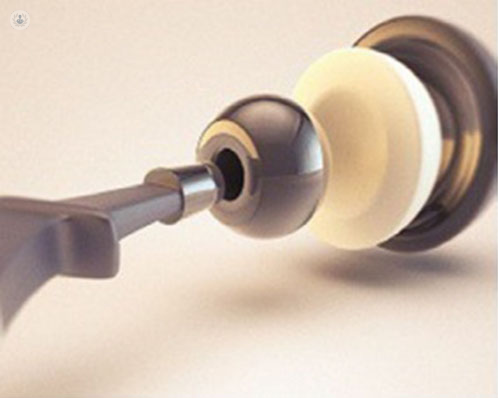Total hip replacement: the latest advancements
Written by:The first successful design of the total hip replacement (THR) was introduced in the 1960s and is now one of the most effective forms of hip surgery. It consists of a stainless steel femoral stem with a metal head and a plastic (polyethylene) socket. Both of these components are cemented into place. The use of a metal ball in a plastic socket remains the most popular choice in hip replacement surgery. If you’d like more information about total hip replacement surgery, make a booking with a consultant orthopaedic surgeon.

Total hip replacement: the latest advancements
Advancements in hip replacements have focused on the longevity of the implants, and in making subsequent revision surgeries easier to perform.
Originally, a total hip replacement procedure was only performed on patients over the age of 70 because of concerns that wear and tear would cause failure. However, due to many patients below the age of 70 in need of total hip replacement surgery, and with higher performance prostheses now being produced, the age limit has been removed.
Patients below the age of 65 that have a total hip replacement surgery, however, will likely require at least one revision procedure during their lifetime.
Possible problem with total hip replacements
Wear and tear over the years following a total hip replacement can lead to tiny polyethylene particles being produced from the connection between metal and plastic, and also from the cement and bone interface. These particles can be as small as bacteria, and so the body’s defence mechanism will try to eliminate the particles by producing enzymes to try to ‘digest’ the particle. These enzymes can leak onto the bone surrounding the implant, resulting in osteolysis, a destruction of the surrounding bone, potentially leading to a loosening or a failure of the implant.
Latest solutions to wear and tear in total hip replacements
-
Uncemented hip replacement
Due to the debris that occurs from the breakdown of the cement used to bond the implant to the bone, alternative bonding solutions have been tried. The aim of these is to form a permanent bond between the implant and the bone, by growing the bone into them. Uncemented hip replacements are used more frequently in younger patients. -
Alternative bearings
To reduce t he particles generated through wear and tear between plastic and metal, alternative bearings are utilised, with materials such as ceramic used. Ceramic offers a very low friction surface. Metal on metal surfaces have also occasionally been used.
he particles generated through wear and tear between plastic and metal, alternative bearings are utilised, with materials such as ceramic used. Ceramic offers a very low friction surface. Metal on metal surfaces have also occasionally been used. -
New plastic
New types of polyethylene have been used that generate fewer particles. Some of the latest developments include vitamin E incorporated into it to improve wear properties.
Latest techniques in hip replacement surgery
There are new techniques emerging in total hip replacement surgical procedures that many surgeons find an exciting challenge. Such examples include:
-
Mini-incision hip replacement
A mini-incision hip replacement can be performed through a 10cm incision. The obvious benefit of this is that it leaves a less visible scar for the patient, and healing time is reduced. Specially designed instruments make this procedure more possible. -
Mini-stems
These are smaller than usual stems, and mean that more bone is preserved when implanted. This makes the implant easier to revise should the need arise. Some of these new designs have only been available for a few years, so the results have yet to be fully understood.


